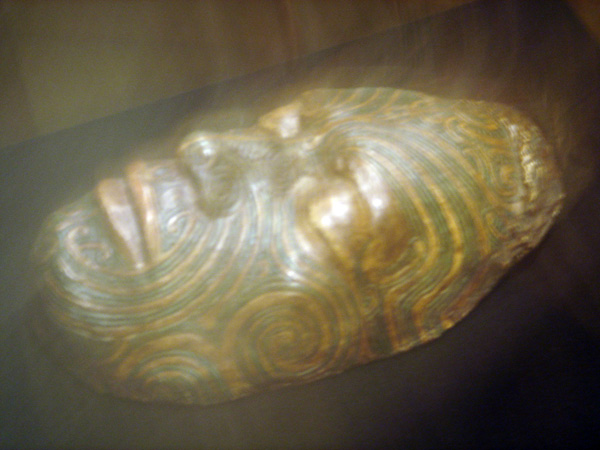
I saw a lot of Charles F. Goldie’s paintings in Auckland and another Goldie painting in Wellington and another in Christchurch; Goldie (1870-1947) painted Maori with full facial tattoos, these tattoos are called moko or ta moko. This particular image shows a tinted cast made of a chief's face after his death; it's in the Te Papa museum in Wellington. I asked the Maroi woman guard if anyone had ta moko anymore, and she said she knew a lot of guys who had it, and they'd all been at a “Power” concert together the night before. I bet those are some heavy dudes. Like Hells Angels so scary they don't even need motorcycles.
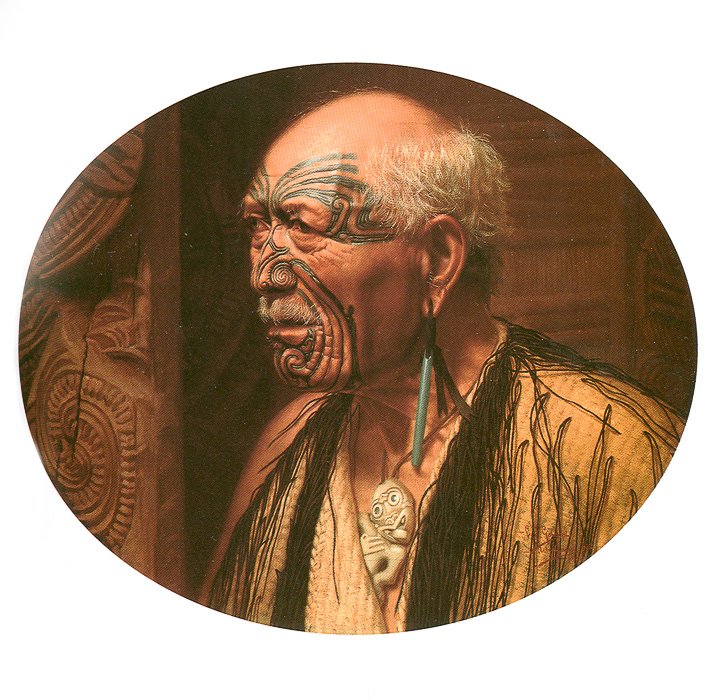
Amazing designs, rich with the arching branches of fern fronds and the curled up spirals of fern fiddleheads. Goldie’s pictures show that the tattoos were in fact carved into the skin. Dig the Tiki necklace he's wearing, you see that litlte man with the crooked head everywhere in Maori art.
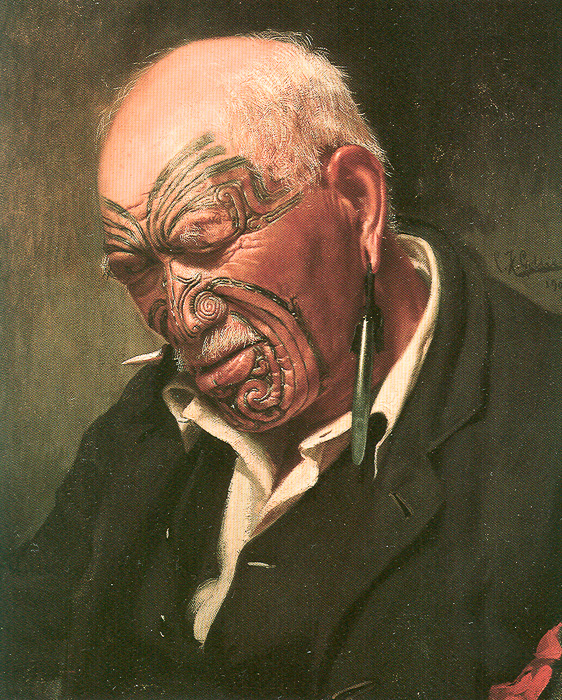
Note that this second painting shows the same man as the first painting, a chief named Patara te Tuhi. This picture is called “A Hot Day.” The Maori posed for Goldie for a daily fee.
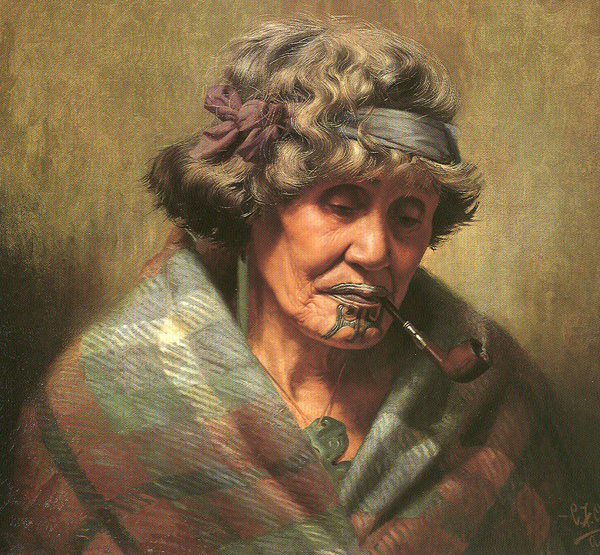
Ina Te Papatahi was one of the first Maori he got to know. The women generally had their moko only on their chins. Also it was only the higher ranking members of the tribes who had moko. Goldie painted Ina many times. In the gallery I heard a guide talking about her, she seems to have been quite a character, involved in intrigues with more than one tribal chieftan.
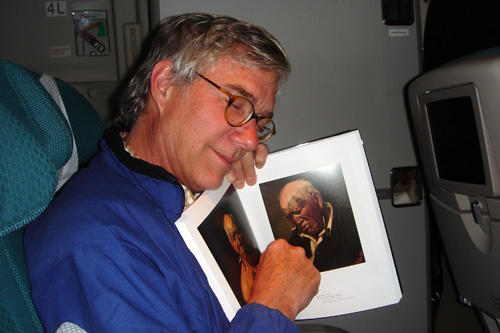
I bought a very interesting book at the Auckland Gallery, Roger Blackley, Goldie, (Auckland art Gallery, 1997). Goldie is a great old-school academic painter.
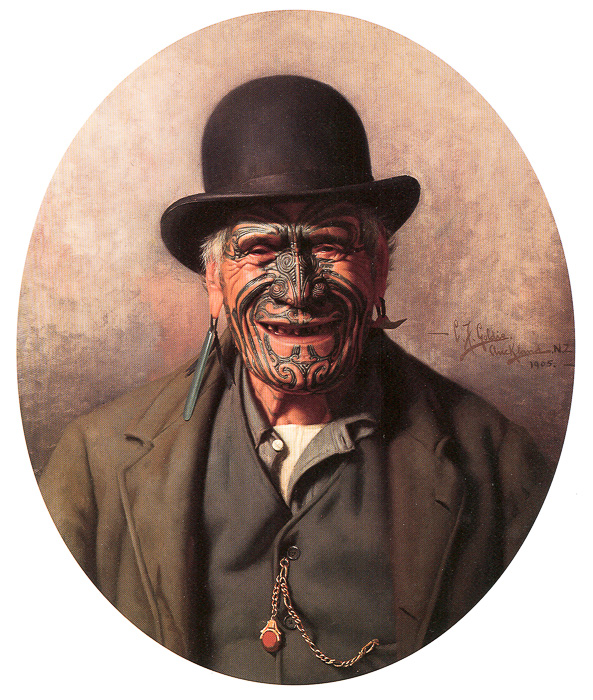
Note that the moko tattoos were around for many years, but the idea of accompanying them with scarification “moko whakairo” became widespread only in the 1820s, according to Pita Graham, Maori Moko or Tattoo (Bush Press, Auckland, 1994). Perhaps the carved moko took hold because at this time the the Maori had metal knives from the Europeans, meaning that they could carve the moko in a little better than with the bone and stone tools they'd used before. This picture is called “All ‘e Same t’e Pakeha” which means, I think, “All Europeans look the same,” or maybe it means “Don't I look European?” — pakeha being the Maori word for European. (Actually some of my commenters say it probably means “All Maori look the same to Europeans.”) It is perhaps a somewhat condescending title, as Goldie had a colonialist kind of attitude toward the Maori. But obviously he was deeply fascinated with them as well. It's a great picture, it would be so cool to hang out with this model (the chief Te Aho-o-te-Rangi Wharepu of the Ngati Mahuta tribe.) Certainly Goldie’s models liked his portraits of them very much; a few letters from the Maori models survive — Goldie would give photos of the paintings to the models.
The flowering of ta moko after European arrival reminds me of how totem poles got big after the natives of the Pacific northwest got steel axes from the traders. In both cases a native art form that had this big flowering right after First Contact — right before the collapse of local culture.
I see this pattern as underlying the metanovel form in Postsingular. It’s a case of extreme Baroque new-technology-mediated form that is fated to collapse due to side-effects of the very tech that makes it possible.
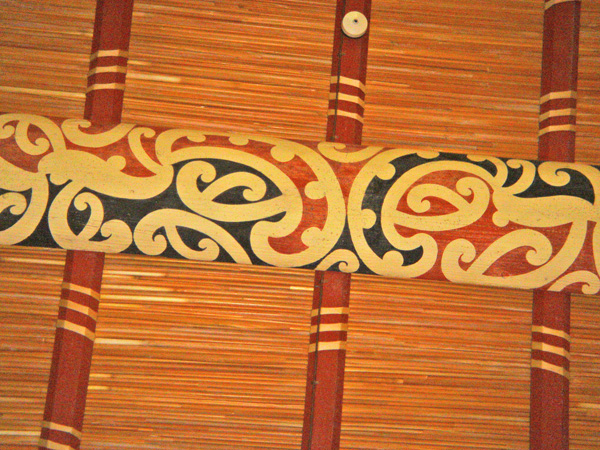
There’s a bit of a renaissance in moko these days, some tough-looking Maori have them now. High street fashion. I don’t think a European could get away with wearing one, at least not in New Zealand. If anyone has links to photos of contemporary moko, let me know.
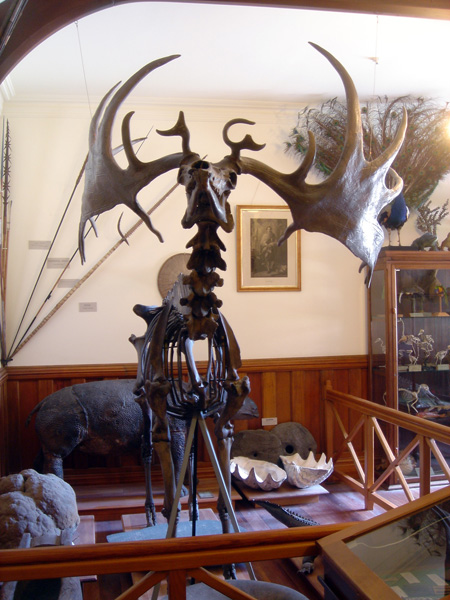
[Irrelevant photo of an Irish Elk skeleton in a jumble room at the Chirschurch museum.]
An interesting grisly sidelight. When someone with a really great moko dies, you hate to throw out that beautifully decorated head. So the Maori sometimes mummified tattooed heads. And then of course traders began wanting to buy them. It’s said that some Maori tribes began deliberately hunting heads off neighboring tribes or even taking a slave, tattooing him, and then the cutting the slave’s head for sale. I want to write a short story which is a nice first-person account of a crew member of a whaling ship who jumps ship in the Bay of Islands near Russell. He has an affair with a Maori woman and is then kidnapped by her tribe. They tattoo him and at first he thinks its an honor, and then he realizes they plan to sell his head. “All 'e same t'e pakeha.” He escapes in a small boat, a storm blows up and he’s swept into higher and higher southern latitudes, towards the mouth of the Hollow Earth! Mocking moko skulls dance around him. [These drawings are from the Bush Press book mentioned above.]
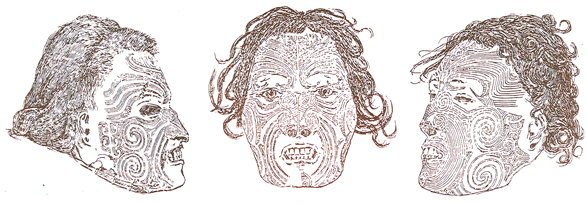









March 22nd, 2008 at 6:48 pm
Tena koe e hoa ma,
These are beautiful portraits of our Tupuna’s, with each detail of a significant turn, has not only a story but that mana that one is gifted.
June 7th, 2008 at 4:57 am
Tena kotou katoa,
Interesting site with a much more interesting comment ‘There’s a bit of a renaissance in moko these days, some tough-looking Maori have them now. High street fashion.’
I am an ex-soldier (Para-trooper & Military Policeman) of 10 years, a university graduate, school teacher and writer; and I wear a facial moko.
I can’t change or update my moko to suit any changes in style, nor do I wish too – ‘High street fashion’ indeed!
I find this comment to be quite shallow and uninformed. The moko is a sacred and meaningful thing and to describe ‘modern moko’ as you have; lessens the cultural significance of both the ‘ta moko’ process and of the moko itself.
June 7th, 2008 at 7:36 am
Brent, thanks for your comment. I freely admit that my knowledge of moko is ‘shallow and uninformed’! I’d welcome any links to sites with better information about the intriguing world of ta moko.
June 8th, 2008 at 8:15 pm
Hi Rudy,
Thanks for your prompt and honest reply – I didn’t mean the comment as a personal attack; if there was any misunderstanding?
The male moko was outlawed by the government (Tohunga Suppression Act) which forbade the act of Maori tattoing. This meant that besides the increasing pressure for many Maori to assimilate into the world of the European; it was also illegal to wear your family crest. The moko is a name, your name, carried by you till you die and this Tohunga Suppression Act denied a number of our forefathers the ‘right’ to display who they were.
The moko, like many other cultural practices from around the world is not well understood by outsiders. Also, the inference that the moko is worn by criminal elements as depicted in the movie ‘Once Were Warriors’ has not helped. It is unfortunate that sometimes the ‘wrong’ elements choose to take on a specific practice for the ‘wrong’ reasons. The moko is a sacred thing and should be respected by those who receive it, those who apply it, and also by those who view it.
The resurgence of the moko is in direct relation to the resurgence and acceptance of the Maori culture within greater New Zealand society. Thank the lord that the Tohunga Suppression Act is not enforceable today – or I would be perceived a criminal, for doing nothing more than carrying my family history.
Hope that provides you with another perspective on the matter.
Cheers
Brent
June 10th, 2008 at 9:38 am
No offense taken, Brent, I’m glad you’re interested in the post, and I appreciate hearing from you.
June 17th, 2009 at 2:27 pm
kia ora kia ora
July 15th, 2009 at 6:19 am
i beleive our tipuna tell us who is to wear ta moko but us irish wore it long time before maori eh figue dat eh eh im not being racist or anything eh but it has been shown eh heapz of secrets eh
July 17th, 2009 at 2:42 pm
Chris, shame your art form has been lost
November 22nd, 2009 at 11:10 pm
Very nice information Great Maori Art
thanks for sharing.
June 7th, 2010 at 6:20 pm
I got an interesting email from the New Zealand artist Ken Hunt on June 7, 2010. It seems I may have misunderstood the meaning of “All the same to E Pakeha”. It may be that “all the same” means something more like, “it makes no difference to”. I’ll quote Ken’s email below.
July 22nd, 2010 at 4:26 pm
Hi Rudy,
I really enjoy your writing – you have a fine sense of humour. I’m a European of NZ descent living in Australia and admit to having a fascination with moko which stems from exposure to Goldie’s paintings as a child. I was also fortunate to see two elderly women with moko. As I am not tangata whenua (people of the land), I haven’t got a moko or in fact, any tattoos which is a minor miracle considering I served in the navy.
I recently borrowed this book from the library and thought you might be interested. Here are the bibliographic details:
Moko : Maori tattoo / photographs by Hans Neleman ; texts by Tame Wairere Iti, Pita Turei and Nicole MacDonald. Zurich : Edition Stemmle, c1999. Neleman, Hans, 1960- 3908161967 (hbk.)
If you conduct a search for Hans Neleman you will locate some of the book’s images.
They are very powerful, poignant and distinguished portraits of a proud people.
Kind regards,
Steven
October 15th, 2011 at 7:29 pm
I just love the Moko and Goldie’s paintings are simply stunning. This has been a good read, I really like what Brent had to say… I am a pakeha from NZ who would love a moko but as a white female with absolutely no maori ancestry, I respect that I can not have one. As far as I have learned there are three parts to the full moko. The forehead is for your status on the Marae. The cheeks are for your whakapapa and the chin is for what you do. Please note, I could have these in the wrong order as it was quite awhile ago someone shared this information with me. Anyway I am pleased to have stumbled accross your website. Thanks.
November 10th, 2011 at 4:41 pm
This book on moko was just released, I picked it up in the library and was blown away by the information and high quality photos. It’s got alot of stories about moko and the people who wear it from the early appearance of it through to modern day.
Hope it helps.
http://www.penguin.com.au/products/9780143566854/mau-moko-world-maori-tattoo
November 15th, 2011 at 6:49 am
ve may bay gia re…
[…]New Zealand, Part 3. Ta Moko. | Rudy’s Blog[…]…
December 10th, 2011 at 11:11 am
I haven’t met such an interesting and readable site yet! Thank you so much for sharing everything. I liked pictures and that book as well.
February 14th, 2012 at 2:26 pm
kewl…i luv his art work…wat a talented man
May 20th, 2012 at 6:43 pm
WHEN WE SHOOKED THE BRITTS AND STOLEN FOR WAR FAIR .IKITO IKINEI RUHETOA
October 15th, 2012 at 12:01 pm
Hey guys, could you tell where I can read about the physical interpretation of the values of Maori tattoo. I wonder how they are recorded in the tattoo belonging to a tribe, the number for the battle, the number of injuries. Perhaps there is an open resource. I can share one link.
http://nzetc.victoria.ac.nz/tm/scholarly/tei-RobMoko.html
But there have only been described in detail tattoo person. but I’m interested in tattoos, applied to the body.
December 7th, 2012 at 1:55 pm
I am researching my ancestry which begins in earnest with the signing of the Treaty of Waitangi. One of the Chiefs who witnessed the signing of the Treaty is my direct antecedent – which one we are not quite sure at the moment. Riki Hana of Rotorua, buried in the Maori cemetery at Otaki, is my great,great grandfather, he being son? grandson? or whatever, of one of the chiefs and this is what we are endeavouring to
ascertain.I find your study of the moto quite fascinating. Each of my three sons has moto. However I would hazard a guess that they (the motos) are not authentic in the terms that you describe. Interestingly, my youngest son is the “dead ringer” of one of Goldie’s chiefs. Love your work!